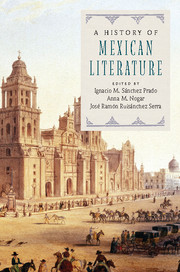Book contents
- Frontmatter
- Contents
- List of contributors
- Introduction
- PART I COLONIAL LITERATURE
- 1 The Languages and Literatures of Early Print Culture in the Colonia
- 2 A Chronicon of Crónicas: The New Spanish Prose Narrative
- 3 Theatricality and the Public Enactment of the Mexican Colonial
- 4 Sor Juana Inés de la Cruz: The Tenth Muse and the Difficult Freedom to Be
- 5 Jesuit Enlightenment: Interventions in Christianity and Intellectualism
- 6 Women in the Print Culture of New Spain
- 7 The Colonial Literary Scope: Empire, Letter, and Power
- 8 New Spain's Archival Past and Present Materiality
- PART II THE NINETEENTH CENTURY
- PART III TWENTIETH AND TWENTY-FIRST CENTURIES
- PART IV MEXICAN LITERATURE BEYOND BOUNDARIES
- Index
- References
1 - The Languages and Literatures of Early Print Culture in the Colonia
from PART I - COLONIAL LITERATURE
Published online by Cambridge University Press: 05 July 2016
- Frontmatter
- Contents
- List of contributors
- Introduction
- PART I COLONIAL LITERATURE
- 1 The Languages and Literatures of Early Print Culture in the Colonia
- 2 A Chronicon of Crónicas: The New Spanish Prose Narrative
- 3 Theatricality and the Public Enactment of the Mexican Colonial
- 4 Sor Juana Inés de la Cruz: The Tenth Muse and the Difficult Freedom to Be
- 5 Jesuit Enlightenment: Interventions in Christianity and Intellectualism
- 6 Women in the Print Culture of New Spain
- 7 The Colonial Literary Scope: Empire, Letter, and Power
- 8 New Spain's Archival Past and Present Materiality
- PART II THE NINETEENTH CENTURY
- PART III TWENTIETH AND TWENTY-FIRST CENTURIES
- PART IV MEXICAN LITERATURE BEYOND BOUNDARIES
- Index
- References
Summary
This chapter critically contextualizes early print culture in sixteenth- and seventeenth-century New Spain by examining the roles of printing houses and their output; the authors whose works circulated in both print and manuscript form; and the members of reading publics, whether elite or marginalized, who formed intellectual nexuses centered on these sites of publishing, textual circulation, and reading. Developing a conversation around what has to date been a largely bibliographical endeavor, this chapter thus opens a new and long-overdue discourse on the impact of print culture on the social and political formation of the colonia.
Establishment of the Printing Press in the Colonia
The early ecclesiastical and civil authorities in the colonia, represented by Archbishop Juan de Zumárraga (held office 1530–1548) and Viceroy Antonio de Mendoza (held office 1535–1550), thought it vital to install a press in New Spain because of the growing role of printed material in evangelization and governmental administration. Mendoza consequently offered a generous contract to Seville-based printer Juan Cromberger, seeking to attract the prestigious and experienced printer and to ensure that the press itself remained functional for printing documents in support of the growing evangelization project and secular government (Millares, 1954: 18; Icazbalceta, 1886: XVI–XVII). Shortly after Mendoza arrived in New Spain to assume his position as its first viceroy, Cromberger sent his representative, a printer from Brescia named Juan Pablos, to establish and run a branch of the Cromberger press in the new viceroyalty (Icazbalceta, 1886: XVI; Millares, 1954: 18; Torre, 1940: 139–141). A royal cédula dated 1542 formalized Mendoza's promise to Cromberger, granting the family the privilege of running the only press in New Spain for ten years. Mendoza and the subsequent viceroy, Luis de Velasco, later extended this privilege through 1558. The cédula also granted the Crombergers a monopoly on the exportation of books to the new colony, which they were authorized to sell at a 100 percent markup (Icazbalceta, 1886: XVI–XVII; Griffin, 1988: 23–24). In return, Cromberger employee Juan Pablos was required to obtain licenses from ecclesiastical and civil authorities for everything he printed (Torre, 1940: 142). This check effectively gave church and government, and Juan Pablos himself, a great deal of control over what was published in New Spain until the monopolistic privilege was revoked in 1558.
- Type
- Chapter
- Information
- A History of Mexican Literature , pp. 17 - 32Publisher: Cambridge University PressPrint publication year: 2016



